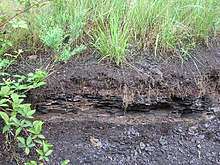Messel Formation
The Messel Formation is a geologic formation in Hesse, central Germany, dating back to the Eocene epoch (about 47 Ma[1]). Its geographic range is restricted to the Messel pit. There it unconformably overlies crystalline Variscan basement and its Permian cover (Rotliegend) as well as Eocene volcanic breccias derived from the basement rocks. The formation mainly comprises lacustrine laminated bituminous shale (‘oil shale’) renowned for its content of fossils in exceptional preservation, particularly plants, arthropods and vertebrates (e.g. Darwinius masillae).
| Messel Formation Stratigraphic range: Eocene | |
|---|---|
 Weathered bituminous shale of the Messel Formation | |
| Type | Formation |
| Thickness | ca 200 m |
| Location | |
| Region | Hesse |
| Country | Germany |
| Type section | |
| Named for | Messel |
References
- Krister T. Smith, Stephan F. K. Schaal, Jörg Habersetzer (eds). "Messel – An Ancient Greenhouse Ecosystem." Schweizerbart, Stuttgart 2018. ISBN 978-3-510-61411-0.
- Various Contributors to the Paleobiology Database. "All datasets matching the term 'Messel'". Paleobiology Database. Retrieved 1 December 2019.
- Jens Lorenz Franzen (2005). "The implications of the numerical dating of the Messel fossil deposit (Eocene, Germany) for mammalian biochronology." Annales de Paléontologie. 91 (4): 329–335. doi:10.1016/j.annpal.2005.04.002
This article is issued from Wikipedia. The text is licensed under Creative Commons - Attribution - Sharealike. Additional terms may apply for the media files.